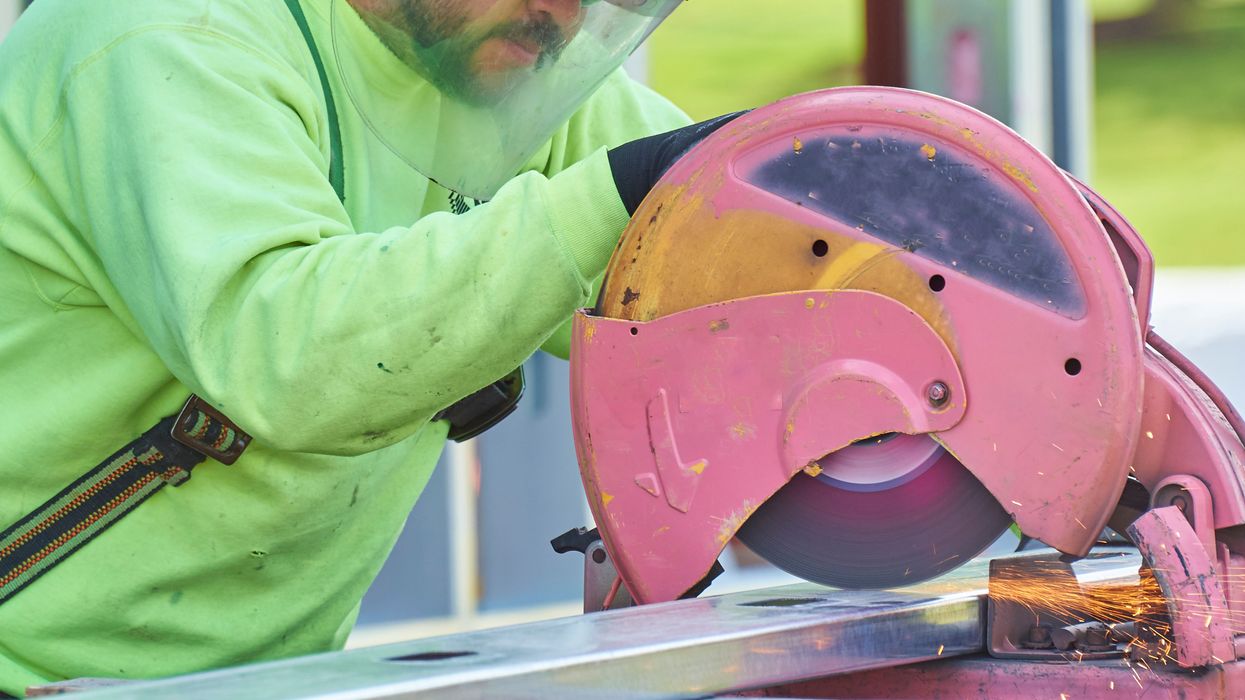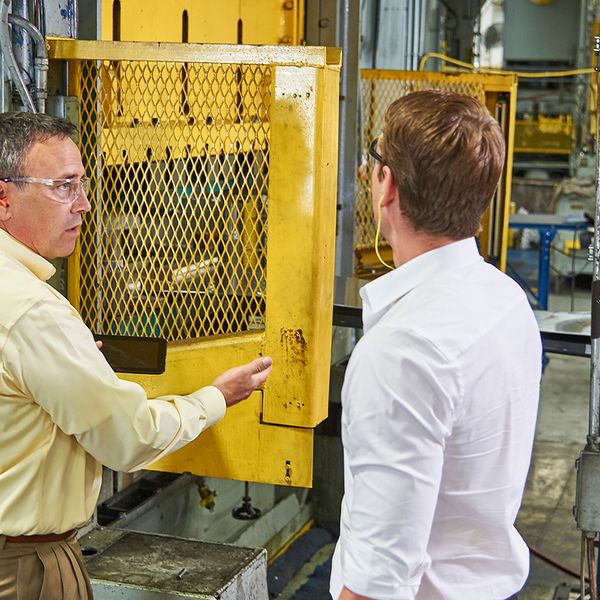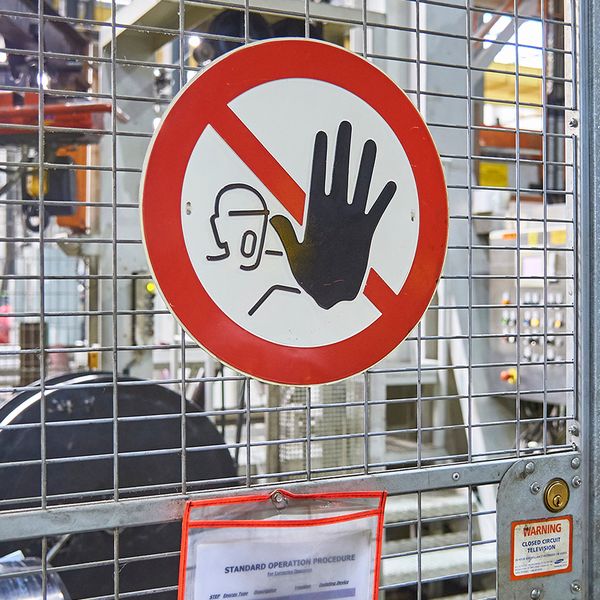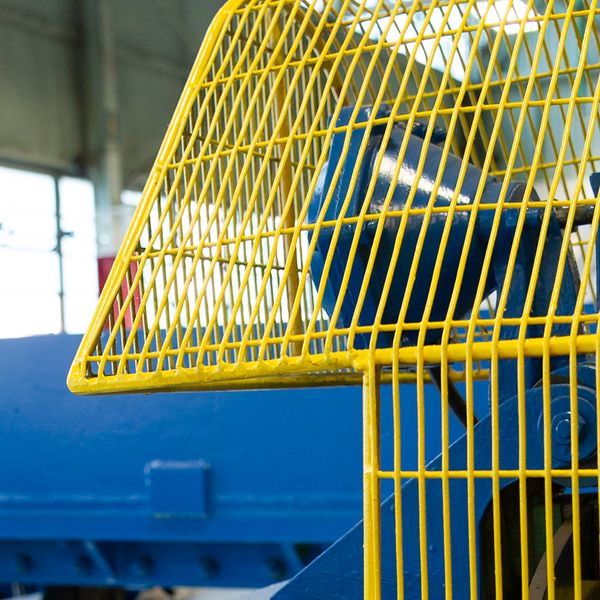Safeguard Handout
Be on guard when protecting workers
Crushed hands and arms, severed fingers, blindness—the list of possible tool and equipment-related injuries is as long as it is horrifying. There seems to be as many hazards created by moving parts as there are types of tools and equipment. Safeguards are essential for protecting workers from needless and preventable injuries.
A good rule to remember is any tool or equipment part, function, or process that may cause injury must be safeguarded. When the operation or accidental contact can injure the worker or others in the vicinity, the hazards must be either controlled or eliminated.
Where do mechanical hazards occur?
Dangerous moving parts in three basic areas require safeguarding:
- The point of operation — that point where work is performed on the material, such as cutting, shaping, or bending.
- Power transmission apparatus — all components of the mechanical system which transmit energy to the part of the tool and equipment performing the work. These components include belts, gears, shafts, pulleys, sprockets, spindles, drums, flywheels, chains, or other reciprocating, rotating, or moving parts of equipment.
- Other moving parts — all parts of the equipment that move while the equipment is working. These can include reciprocating, rotating, and transverse moving parts, as well as feed mechanisms and auxiliary parts of the tool and equipment.
What equipment causes amputations?
Amputations occur most often when workers operate unguarded or inadequately safeguarded equipment motors, conduit-bending equipment, saws, drill presses in fabrication shops, and grinders. These injuries happen during material handling activities, pinch point hazards while using telehandlers, opening and closing sharp equipment doors, or using powered and non-powered hand tools.
Besides normal operation, the following activities involving tools and equipment also expose workers to potential amputation hazards:
- Setup/threading/preparation for regular operation;
- Making running adjustments to materials being cut, bent, or compressed;
- Cleaning;
- Oiling or greasing;
- Scheduled/unscheduled maintenance; and
- Locking out or tagging out.
What are the requirements for safeguards?
Safeguards must meet these minimum general requirements:
- Prevent contact: The safeguard must prevent hands, arms, and any other part of a worker’s body from making contact with dangerous moving parts;
- Secure: Workers should not be able to remove or tamper with the safeguard easily. Guards and safety devices should be made of durable material that will withstand the conditions of normal use;
- Protect from falling objects: The safeguard should ensure that no objects can fall into moving parts;
- Create no new hazards: The edges of guards should be rolled or bolted so that they eliminate sharp edges;
- Create no interference: Any safeguard which impedes a worker from performing the job quickly and comfortably might soon be overridden or disregarded; and
- Allow safe lubrication: If possible, workers should lubricate the equipment without removing the safeguards. Locating oil reservoirs outside the guard, with a line leading to the lubrication point, will reduce the need for the worker to enter the hazardous area.
Understanding the dangers of moving parts and recognizing hazardous mechanical motions and actions, ensuring that the safeguards meet requirements, and training workers are steps supervisors should take to ensure safe tool and equipment operation.
Training is crucial in safeguarding workers
Training is essential for worker protection, but OSHA’s construction industry standards on tool and equipment guarding don’t have any general requirements for worker training. OSHA’s Abrasive wheels and tools; Woodworking tools; Jack-lever and ratchet, screw, and hydraulic; Air receivers; and Mechanical power-transmission apparatus standards don’t discuss training requirements for workers under 1926 Subpart I.
However, under the General Duty Clause, an employer has a responsibility to provide “a place of employment which is free from recognized hazards that are causing or are likely to cause death or serious physical harm to his [workers].” OSHA can issue a citation for a violation of the General Duty Clause if the lack of training is a recognized hazard that’s causing or is likely to cause death or serious injury or harm to workers.
For example, an OSHA general duty clause citation that mentions training workers in the operation of a pipe threading equipment states, in part,
“ ... Elements essential to an acceptable safe operating procedure include at a minimum: ... 2) Provide training and education to the [workers] concerning all the appropriate procedures for the safe operation and use of this type of [equipment]. ...”
Thorough worker training should involve instruction or hands-on training in the following:
- A description and identification of the hazards associated with particular tools and equipment;
- The safeguards themselves, how they provide protection, and the hazards for which they are intended;
- How to use the safeguards and why;
- How and under what circumstances safeguards can be removed, and by whom (in most cases, by a mechanic only); and
- What to do (e.g., contact the supervisor) if a safeguard is damaged, missing, or unable to provide adequate protection.
The tool and equipment manufacturer’s instruction manual is an excellent source of information on the equipment’s proper inspection, use, and maintenance procedures. The information provided in operating manuals is specific to the equipment and provides the details necessary for safe operation. Other sources of information on the safe use would be any available industry consensus standards (e.g., ANSI, ASME, or other organizations’ standards) developed for that type of tool or equipment.
This kind of safety training is necessary for workers when any new or altered safeguards are put in service or when workers are using tools or equipment on the job.
Hazard recognition
Virtually all tools or motors with moving parts on a jobsite can be considered potentially dangerous. Despite your efforts to protect operators and other workers from those hazards, workers should understand that not all hazards may have been anticipated, identified, and guarded. Sometimes even a subtle change in how a tool is used can expose workers and others in the area to new hazards. An effective hazard recognition process provides the best protection against previously unanticipated risks.
Each worker is a key player in the hazard recognition process, and all workers should:
- Know how to recognize, inspect, and properly adjust tool and equipment safeguards;
- Always think about potential hazards before they operate the equipment. Workers should be aware of all moving parts and potentially dangerous work areas, and they should know not to reach into equipment if they aren’t certain that it’s safe;
- Be aware of their coworkers’ actions. If they see someone doing something they think may be dangerous, they should speak up;
- Anticipate the unexpected. Workers shouldn’t assume that safeguards and warning signs always completely eliminate all potential hazards; and
- Know how to report hazards.
Effective hazard recognition requires cooperation between project management and workers. Management must ensure that workers are trained to recognize potential hazards in their work areas. Workers must know that management will respect a worker’s decision to evaluate and report a potentially dangerous situation.
Remember, even the most elaborate safeguarding system cannot offer effective protection unless the worker knows how to use it and why. Specific and detailed training is therefore a crucial part of any effort to provide safeguarding against equipment-related hazards and serious injuries.

















































